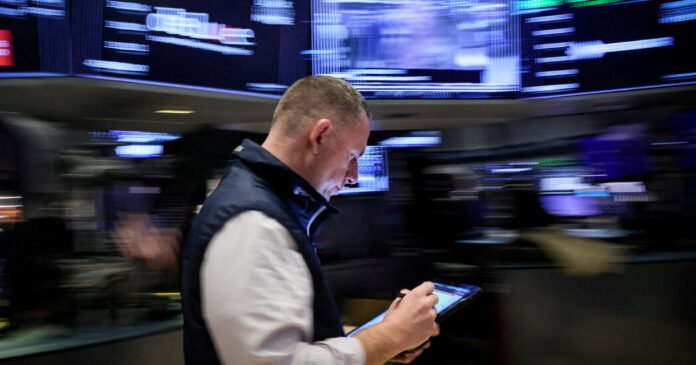[ad_1]
Wall Street is back in rally mode, with investors seizing on the latest sign that interest rates could begin to fall this year.
The S&P 500 rose 1.2 percent on Wednesday, adding to three straight weeks of gains and climbing above its previous record, set on March 28.
It marks a sharp shift from the sour mood that helped pull the index more than 5 percent lower at the beginning of April, as investors got used to the idea that high interest rates might stick around for longer, weighing on the economy and the markets.
Fresh inflation data on Wednesday morning provided the catalyst for the index to cross through its previous record. The S&P 500 is now nearly 7 percent above its most recent low in April.
Wednesday’s report — data from the closely watched Consumer Price Index — showed a modest slowdown in the pace of rising prices, in line with economists’ expectations. Investors welcomed the numbers and a return to the trend of gradually receding inflation after months of disappointing data that had upset financial markets and sent stock prices lower.
“This is the first good C.P.I. report in four months and the market likes it,” said Gary Pzegeo, head of fixed income at CIBC Private Wealth US.
Early in the year, investors had largely shrugged off stubbornly high inflation data, choosing to focus instead on robust growth underpinning the stock market. That propelled the market to repeated records through March.
Then in early April, things took a turn. After a third successive C.P.I. report undermined the trend of gradually slowing inflation, worries began to set in that the Federal Reserve might not just delay rate cuts but actually increase interest rates. The S&P 500 fell for three weeks in a row, its worst run of the year so far, slipping a total of 5.5 percent from its high through April 19.
Investors turned more hopeful again this month, when the Fed chair, Jerome H. Powell, poured cold water on the likelihood that the central bank would raise interest rates. Then a report last week showing a slowdown in hiring in April, along with more meager wage inflation, brought the possibility of rate cuts this summer back into the picture, giving the stock market a boost.
“Those two things have really helped the stock market,” said David Kelly, chief global strategist at J.P. Morgan Asset Management.
Wednesday’s C.P.I. report had been seen as the next major test for the market, either undermining the relief that stemmed from April’s jobs report, or, as proved to be the case, supporting it.
The two-year Treasury yield, which is sensitive to changes in interest rates, has fallen to just above 4.70 percent from over 5 percent at the end of April, as fears of rates moving higher have cooled. The benchmark 10-year Treasury yield, which underpins borrowing across the world, has fallen back to around 4.35 percent from 4.7 percent, over the same period.
Investors in futures markets are now betting that the Fed is likely to lower interest rates by a quarter of a percentage point in September, assuming no further disruptions to disinflation that could push stocks lower.
Another important tailwind has been better-than-expected earnings results, with corporate leaders spending the past few weeks updating investors on their profitability over the first three months of the year, and where they see the economy headed from here.
Corporate earnings have so far grown 5.4 percent, with just over 90 percent of companies reporting their financial results, as of Friday. At the end of March, analysts were expecting growth of just 3.4 percent.
On Friday the S&P 500 notched its third straight week of gains, a feat it hadn’t managed since mid-February. Importantly, the Russell 2000 stock index of smaller companies that are more exposed to the ebb and flow of the American economy, is also now positive this year, after rallying in recent weeks. The index rose 1 percent on Wednesday.
Mr. Kelly said that after the “tumultuous” changes over recent years — including the pandemic, and the wars in Ukraine and Gaza — an “equilibrium” has begun to return to the economy.
“We are settling into a boring economy and boring can last a long time,” he said.
J. Edward Moreno contributed reporting.
[ad_2]
Source link

